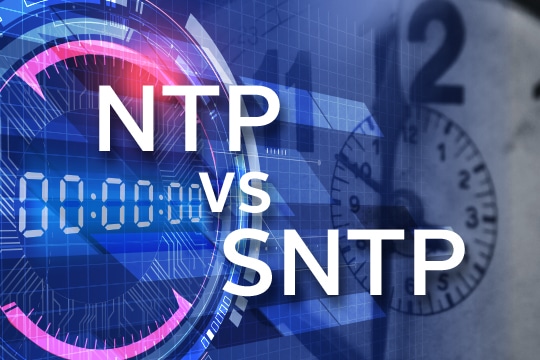NTP vs. SNTP: What’s the Difference?
And Which One Do You Really Need?
NTPNTP, or Network Time Protocol, is a widely used networking protocol that enables computers and devices to synchronize their system clocks with a reference time source. It ensures accurate timekeeping in computer networks by allowing devices to obtain precise time information from NTP servers, which are typically synchronized to highly accurate atomic clocks. NTP is essential for various applications and services that rely on synchronized time, such as network security, authentication, and data logging. (Network Time Protocol) and SNTP (Simple Network Time Protocol) are similar TCP/IP protocols in that they use the same time packet from a Time Server message to compute accurate time. The procedure used by the Time Server to assemble and send out a time stamp is exactly the same whether NTP (i.e., full implementation NTP) is used, or SNTP is used.
The difference between NTP and SNTP is important in the time synchronization program running on the client side on each system.
The time synchronization program, whether it is a Windows built-in program like W32Time (which uses the SNTP protocol) or a third-party add-on, determines which protocol is being used — not the time server. The time server does not care. The difference between NTP and SNTP is in the error checking and the algorithm for the actual correction to the time itself.
The NTP algorithm is much more complicated than the SNTP algorithm. NTP normally uses multiple time servers to verify the time and then controls the slew rate of the system. The algorithm determines if the values are accurate using several methods, including fudge factors and identifying time servers that don’t agree with the other time servers. It then speeds up or slows down the system clock’s drift rate so that (1) the system’s time is always correct and (2) there won’t be any subsequent time jumps after the initial correction.
Unlike NTP, SNTP usually uses just one time server to calculate the time, then “jumps” the system time to the calculated time. It can, however, have back-up time servers in case one is not available. During each interval, it determines whether the time is off enough to make a correction and if it is, applies the correction.
Clear as Mud?
If this is not completely clear, consider an analogy of comparing and adjusting a wristwatch to a clock on the wall. The wristwatch is analogous to the “client” device (like a PC) and the clock on the wall is the time server. With SNTP, you always look at the clock at pre-determined intervals. Let’s say one per hour. (As an aside, the act at comparing time for computer synchronization is known as a “poll.”)
When you think it is 12:00:00 you look at (poll) the clock to see that it is 11:59:57. You are three seconds fast, so you set your watch back three seconds. You do not do anything else until 1:00:00. You look again at the clock to see that it is 12:59:57 – again, three seconds fast — and again you set your watch back three seconds. Every hour, you reset your watch 3 seconds to be in sync with the clock on the wall.
From an error perspective, you are most accurate immediately after the poll and you progressively get worse. The maximum error happens immediately before the poll, when a sudden adjustment occurs, such as when time goes from 12:59:57 to 12:59:58 to 12:59.59 to 1:00:00 to 12:59:57.
If a maximum error of three seconds and the discontinuity of the time scale bothers you, consider the NTP case. Here, you want to react knowing that your watch is gaining three seconds every hour, so you don’t have to change it so often.
Simply compensate for the drift by using your error vs. time measurements. You do not need to use the same measurement period all the time. All you need to know is the rate and direction of the change.
After you have a pretty good feel for the drift, you can program your watch to adjust in real time. You want to make very small adjustments, so that at any given time you are in sync with the clock on the wall, without even looking at it.
Of course, the drift rate may change over time, so you do want to continually poll the clock, and apply the best correction you can come up with. And with that you get a wristwatch that is seemingly never out of synchronization!
Which One Do You Need?
It all depends on your application, but in general, SNTP clients should only be used where time synchronization is not critical for your systems. For all other clients, and for systems that will also serve time to other systems, you should utilize full NTP implementations to include reference selection and clock steering algorithms to maintain accuracy through the full timing path.
Looking at the time servers themselves, the selection of a time server that uses SNTP or NTP to serve time only should focus on whether that time server would ever synchronize to NTP as a primary or secondary reference — in which case, only full NTP should be used. To simplify things, SNTP should be used only at the start or end of the network timing path, and only at the end of the network timing path where time synchronization is not critical for your systems.


